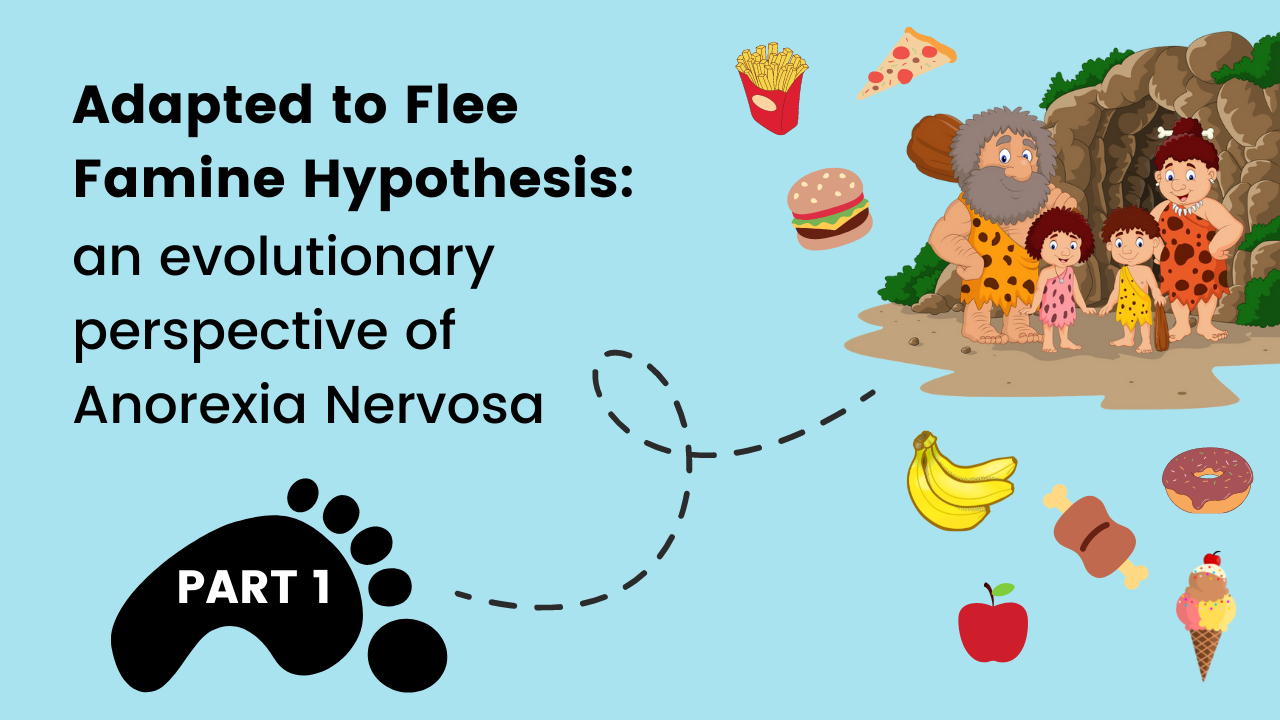An Evolutionary Perspective of Anorexia Nervosa (Adapted to Flee Famine Hypothesis PART 1)
Mar 14, 2022
I am SO excited to be starting a 7-part series all about the Adapted to Flee Famine Hypothesis! If you are a long-time reader of the blog, watcher of my YouTube channel, or listener of my podcast, you know I am a huge believer in breaking down scientific concepts to help you understand and overcome any mental health issues you may face. This post is part 1 of the series I am doing on a highly requested topic regarding the evolutionary biology of Anorexia. More specifically, I’ll be explaining the Adapted to Flee Famine Hypothesis, a theory by Clinical Psychologist & Evolutionary Biologist Dr. Shan Guisinger.
One of the BIGGEST myths about Anorexia is that someone who struggles with the illness perceives themselves to be fat. When you look up the definition of Anorexia on Google, the VERY FIRST result is the following:
“Anorexia is characterized by a distorted body image, with an unwarranted fear of being overweight. Symptoms include trying to maintain a below-normal weight through starvation or too much exercise. Medical treatment may be needed to restore normal weight. Talk therapy can help with self-esteem and behavior changes.”

This definition implies that Anorexia is caused by low self-esteem, body image issues, and an intense fear of becoming fat. I mean, I’m sure we’ve all seen that stereotypical image of a skeletal girl looking in the mirror and having an overweight person staring back. It’s this very stereotype however, that I believe led me to deny my illness for so long and frankly, allow it to almost kill me when I was 17 years old.

I never resonated with the stereotypical description of “wanting to be thin” or “feeling like I needed to lose weight”. I have always had a very small frame, and I was fully aware of this, even when I was in the throes of anorexia. When I was at my lowest weight, I KNEW how skeletal I looked. I KNEW that if I didn’t eat more, exercise less, and gain weight, I WOULD DIE. And trust me, I WANTED to gain weight, I really did. I hated the disgusted stares when I went outside, and I truly did WANT to look like a normal girl. Yet, for some reason, I just couldn’t get myself to eat more.
Because my eating disorder started at the young age of 11, I was forced into treatment for many years. I endured hours and hours of talk therapy - CBT, DBT, PRI, mindfulness exercises, and all of the other traditional methods used to treat eating disorders nowadays - but NONE of it helped. In fact, all of this forced treatment just made my eating disorder worse. The more I was told to “just eat”, the more I rebelled and “just didn’t eat”.
Every new therapist had their own theory to what “trauma” caused my eating disorder, but to this day I can tell you there was no “trauma”. Now, I’m not saying I didn’t have traumatic experiences in my life because trust me, I did! We all do. But if trauma was the sole cause of an eating disorder, every single person to walk this earth would be walking around with an eating disorder! And we all know that’s not the case.
So then, what IS the case? Why do so many people with anorexia want to eat more and want to rest and want gain weight, but remain unable to align their actions with those intentions? This is where the Adapted to Flee Famine Hypothesis comes in, which takes an evolutionary perspective on Anorexia Nervosa. When I learned about this theory, my entire life changed for the better. With this 7-part series I have created, I hope to pass on my own knowledge so your life can hopefully change for the better too!
Before diving in, I want to briefly let you know what you can expect from all 7 parts of this series because as an autistic person, I always love to know what’s to come!
What to Expect
Part 1: I’ll be giving a quick overview of the AFFH and explain how illnesses can be seen from different analytical perspectives.
Part 2: you’ll learn about four fields of theories that have been used to try and understand Anorexia, and why each of these theories fails to fully explain the complex and paradoxical illness. Not to mention, why traditional eating disorder treatment approaches often fail.
Part 3: I’ll be unpacking exactly what the Adapted to Flee Famine Theory is, and how it provides a (r)evolutionary perspective in the field of Anorexia research.
Part 4, 5, and 6: The Adapted to Flee Famine Hypothesis proposes three core adaptations which are restriction, hyperactivity, and denial of starvation. I will be explaining the science behind each of these core adaptions in 4th, 5th, and 6th videos.
Part 7: I’ll be giving the treatment implications using the AFFH; you’ll learn how the AFFH can be used to fully recover from Anorexia.
Overview of the Adapted to Flee Famine Hypothesis
First up, an overview of the Adapted to Flee Famine theory! It is no secret that Anorexia is a paradoxical illness. People with Anorexia are often as mystified by their symptoms as those around them. Why do they abstain from food even though they know they need to gain weight? Why do they feel driven to exercise even though they know it’s harmful? Why do they lie and manipulate even though they are generally kind, good-hearted souls?
Society’s current understanding of AN is derived primarily from psychosocial and biomedical theorizing and research. The seriousness of Anorexia’s life-threatening and even delusional symptoms has led clinicians to assume serious psychopathology in the patients or in their families. What is lacking in these conclusions, however, is evidence to support the direction of causality.
Rather than stating that psychological or medical pathology causes the bizarre behaviors and cognitions of Anorexia, the Adapted to Flee Famine Hypothesis adds an evolutionary perspective and provides evidence to why it is weight loss that leads to a full-blown eating disorder.
Levels of Analysis
It is important to understand that psychological and physical disorders can be explained from several different perspectives. For example, the question “Why is this person obese?” may be answered in the context of proximate or “how” questions, investigating the individual origin of the disorder including family factors, personality variables, societal conditions, and hormonal and neurochemical mechanisms. In contrast, ultimate or “why” questions, might investigate the evolutionary origins of obesity as an adaptation to an environment characterized by frequent famine.
The proximate or “how” questions have been the focus of the most current theories and research on Anorexia Nervosa, overlooking evolutionary explanations and animal models. Although a considerable amount of data supports the various psychological, sociological, and biomedical theories, there are several inconsistencies across the theories, and no single theory accounts for all aspects of the disorder.
So what are these current theories and why are they inconsistent? We’ll be discussing them, and more in the next post! Be sure to subscribe to my newsletter so you’ll be the first to know when the upcoming post goes live!




